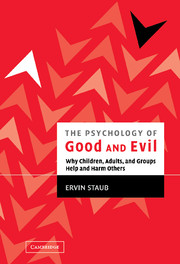Book contents
- Frontmatter
- Contents
- Preface
- Acknowledgments
- PART I INTRODUCTION AND CORE CONCEPTS
- PART II THE ROOTS OF HELPING OTHER PEOPLE IN NEED IN CONTRAST TO PASSIVITY
- PART III HOW CHILDREN BECOME CARING AND HELPFUL RATHER THAN HOSTILE AND AGGRESSIVE
- PART IV THE ORIGINS OF GENOCIDE, MASS KILLING, AND OTHER COLLECTIVE VIOLENCE
- 21 A Note on the Cultural–Societal Roots of Violence
- 22 The Psychology of Bystanders, Perpetrators, and Heroic Helpers
- 23 Steps Along a Continuum of Destruction: Perpetrators and Bystanders
- 24 The SS and the Psychology of Perpetrators: The Interweaving and Merging of Role and Person
- 25 The Origins of Genocide: Rwanda
- 26 Bystanders as Evil: The Example of Rwanda
- 27 Individual and Group Identities in Genocide and Mass Killing
- 28 Mass Murder: U.S. Involvement as Perpetrator, Passive Bystander, Helper
- 29 When Instigation Does Not Result in Mass Murder
- 30 Persian Gulf Conflict Was Reflection of Stormy Undercurrents in U.S. Psyche
- 31 Mob Violence: Cultural–Societal Sources, Instigators, Group Processes, and Participants
- 32 Understanding and Preventing Police Violence
- PART V THE AFTERMATH OF MASS VIOLENCE: TRAUMA, HEALING, PREVENTION, AND RECONCILIATION
- PART VI CREATING CARING, MORALLY INCLUSIVE, PEACEFUL SOCIETIES
- Appendix: What Are Your Values and Goals?
- Index
- References
29 - When Instigation Does Not Result in Mass Murder
Published online by Cambridge University Press: 07 May 2010
- Frontmatter
- Contents
- Preface
- Acknowledgments
- PART I INTRODUCTION AND CORE CONCEPTS
- PART II THE ROOTS OF HELPING OTHER PEOPLE IN NEED IN CONTRAST TO PASSIVITY
- PART III HOW CHILDREN BECOME CARING AND HELPFUL RATHER THAN HOSTILE AND AGGRESSIVE
- PART IV THE ORIGINS OF GENOCIDE, MASS KILLING, AND OTHER COLLECTIVE VIOLENCE
- 21 A Note on the Cultural–Societal Roots of Violence
- 22 The Psychology of Bystanders, Perpetrators, and Heroic Helpers
- 23 Steps Along a Continuum of Destruction: Perpetrators and Bystanders
- 24 The SS and the Psychology of Perpetrators: The Interweaving and Merging of Role and Person
- 25 The Origins of Genocide: Rwanda
- 26 Bystanders as Evil: The Example of Rwanda
- 27 Individual and Group Identities in Genocide and Mass Killing
- 28 Mass Murder: U.S. Involvement as Perpetrator, Passive Bystander, Helper
- 29 When Instigation Does Not Result in Mass Murder
- 30 Persian Gulf Conflict Was Reflection of Stormy Undercurrents in U.S. Psyche
- 31 Mob Violence: Cultural–Societal Sources, Instigators, Group Processes, and Participants
- 32 Understanding and Preventing Police Violence
- PART V THE AFTERMATH OF MASS VIOLENCE: TRAUMA, HEALING, PREVENTION, AND RECONCILIATION
- PART VI CREATING CARING, MORALLY INCLUSIVE, PEACEFUL SOCIETIES
- Appendix: What Are Your Values and Goals?
- Index
- References
Summary
Ethnic, religious, political, or national groups can coexist, as they do in Switzerland and in the United States. In Tanzania, in contrast to the rest of Africa, ethnic groups have lived together harmoniously. This is in part because there are a number of groups, and none has been dominant. Also, the different groups live in the periphery of the country with relatively limited contact. In addition, until recently, government policy has actively prohibited ethnic association and organization (Young, 1998).
Inattention to past violence between groups and to the resulting wounds may be a serious problem, as in the case of the former Yugoslavia, where Marshal Tito maintained such a policy. Prohibiting ethnic association creates some danger when the policy is lifted and other circumstances change; the earlier prohibition intensifies the focus on ethnicity. In Tanzania, there has recently been such an increased focus. Probably the best policy is to create structures that protect each group's rights and interests, foster connections, promote shared goals, and provide education about each other.
The conception I advanced offers explanation for why instigating conditions at times do not lead to group violence. Less intense instigating conditions, weaker cultural predisposing characteristics, more positive behavior of leaders, and less use of scapegoating and destructive ideologies – partly perhaps because of the nature of cultural characteristics – all may have a role. Active bystanders seem especially important.
- Type
- Chapter
- Information
- The Psychology of Good and EvilWhy Children, Adults, and Groups Help and Harm Others, pp. 368 - 372Publisher: Cambridge University PressPrint publication year: 2003



